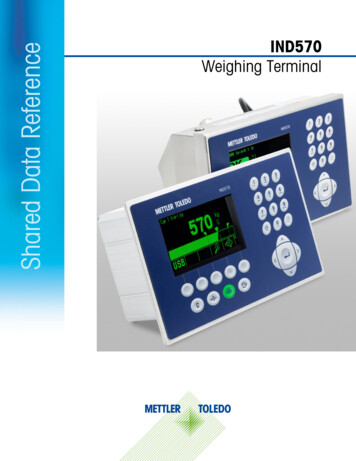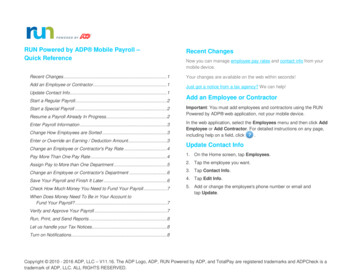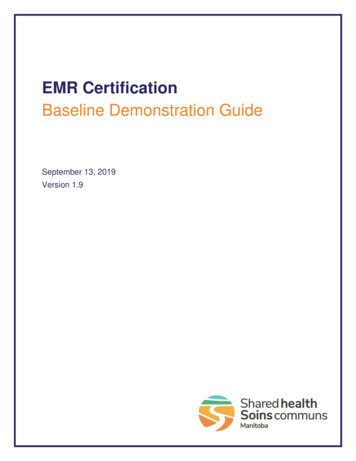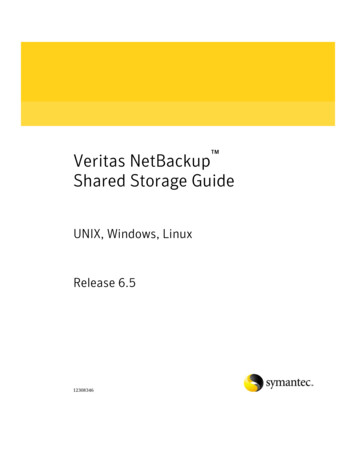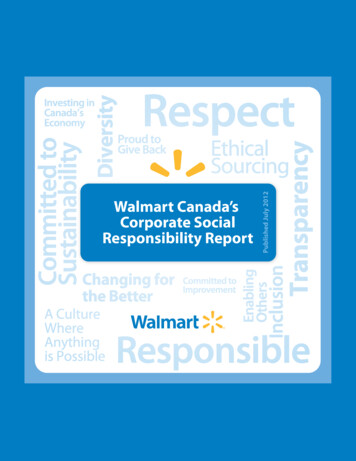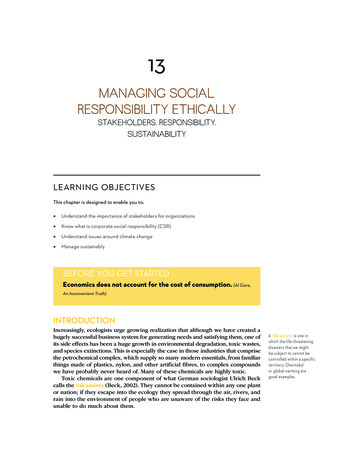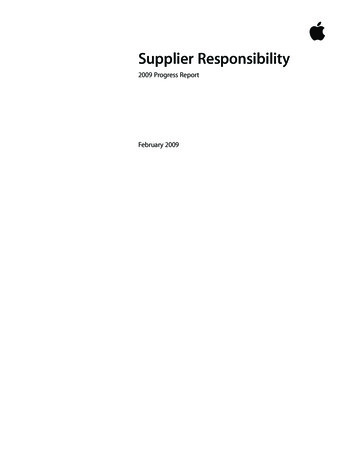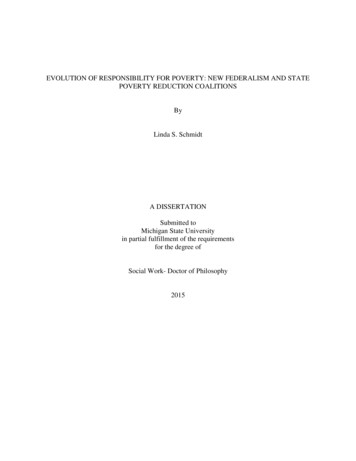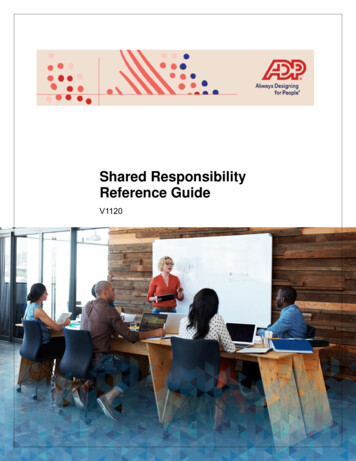
Transcription
Shared ResponsibilityReference GuideV1120
TrademarksThe ADP Logo is a registered trademark of ADP, Inc. Always Designing for People is a trademark of ADP, Inc.Copyright 2020 ADP, Inc. ALL RIGHTS RESERVED. ADP and RUN Powered by ADP are registered trademarks of ADP, Inc. andits affiliates. All other trademarks are the property of their respective owners. ADP PROPRIETARY AND CONFIDENTIAL.ADP provides this publication “as is” without warranty of any kind, either express or implied, including, but not limited to, the impliedwarranties of merchantability or fitness for a particular purpose. ADP is not responsible for any technical inaccuracies or typographicalerrors which may be contained in this publication. Changes are periodically made to the information herein, and such changes will beincorporated in new editions of this publication. ADP may make improvements and/or changes in the product and/or theprograms described in this publication at any time without notice.SRRG – V1120Copyright 2020 ADP, Inc. ALL RIGHTS RESERVED.2Shared Responsibility Reference Guide
ContentsShared Responsibility . 4Full Time Equivalent (FTE) Calculator . 5Full-Time Equivalency Year .5Full-Time Equivalency Results .5Full-Time Employees .6Full-Time Equivalent (FTE) Employees .6Seasonal Employees .6Controlled Group and Related Employers .7ACA - Employee Detail Report . 8Section 1 – Report Name and Year .9Section 2 – FTE Determination.9Section 3 – Calculation Method . 10Section 4 – Detail . 10How are Full-Time Employees and FTEs Determined? . 11Calculations. 12Where Do I Get More Help? . 13Copyright 2020 ADP, Inc. ALL RIGHTS RESERVED.3Shared Responsibility Reference Guide
Shared ResponsibilityBeginning in 2015, the Shared Responsibility provision of the Affordable Care Act (ACA)mandates that applicable large employers (i.e., those with 50 or more full-time andfull-time equivalent (FTE) employees during the preceding calendar year) must offergroup health coverage to their full-time employees (and dependents up to the age of 26)with the following criteria or potentially be liable for a penalty: Offer full-time employees the opportunity to enroll in Minimum EssentialCoverage (MEC) under an employer plan.Offer full-time employees’ coverage that is affordable.Resources for additional information about Minimum Essential Coverage (MEC) andhow to determine if coverage is affordable can be found in the Where Do I Get MoreHelp? section of this guide.The penalties apply if both above conditions are not met and at least one of thecompany's full-time employees purchase coverage through a health insurancemarketplace and is eligible for and receives a premium tax subsidy to help pay for theirhealth coverage.Employers with fewer than 50 full-time (FT) and full-time equivalent (FTE) employeesare not subject to such a penalty regardless of whether they offer health coverageand/or employees purchase coverage through a marketplace. When determining if anemployer is an applicable large employer (ALE), all companies that are part of a“controlled group” must be considered. See Controlled Group and Related Employersfor more information.The tools provided in the payroll application will help you as you determine whether yourcompany may be considered an applicable large employer and, therefore, subject toShared Responsibility.Copyright 2020 ADP, Inc. ALL RIGHTS RESERVED.4Shared Responsibility Reference Guide
Full Time Equivalent (FTE) CalculatorTo assist you in determining if your company may be an applicable large employer(ALE), and therefore subject to Shared Responsibility, the payroll application will helpyou calculate the number of Full-Time employees (FT) and Full-Time Equivalent (FTE)employees from the employee information you enter in the payroll application. Each timethe Affordable Care Act page is accessed, the FTE Calculator calculates the number ofFT/FTE employees with the most recent information entered in the payroll application.This ensures results always show the most current information.Full-Time Equivalency YearTo determine if your company may be considered an ALE for the current year, you mustselect the preceding calendar year. For example, to determine if you may be considereda large employer for 2020, select the year 2019.Full-Time Equivalency ResultsThe annual average of full-time plus full-time equivalent employees.You may not be considered an Applicable Large Employer: Your calculated resultscame back with fewer than 50 full-time (FT) and full-time equivalent (FTE) employees. Ifyou have related entities making you part of a controlled group for ACA purposes, theFT and the FTE count for each entity must be combined to determine the employeecount. See Controlled Group and Related Employers for more information.You may be considered an Applicable Large Employer: Your calculated resultscame back with 50 or more full-time (FT) and full-time equivalent (FTE) employees. Ifyou have related entities making you part of a controlled group for ACA purposes, theFT and the FTE count for each entity must be combined to determine the employeecount. See Controlled Group and Related Employers for more information.Copyright 2020 ADP, Inc. ALL RIGHTS RESERVED.5Shared Responsibility Reference Guide
Full-Time EmployeesEmployees who worked on average 30 or more hours per week (or 130 or more hoursper month). See How are Full-Time Employees and FTEs Determined? for moreinformation. Full-Time Equivalent (FTE) EmployeesThe full-time equivalent of part-time employees (those who worked on average less than30 hours per week). For the FTE calculation, the monthly hours for part-time employeesare combined and then divided by 120.See How are Full-Time Employees and FTEs Determined? for more information.Note: If the part-time employee works more than 120 hours but less than 130 hoursduring the month, only 120 hours must be included in the calculation.Seasonal EmployeesUnder the ACA, an employer is not considered “an applicable large employer” if theyexceed 50 full-time (FT) and full-time equivalent (FTE) employees for 120 or fewer daysduring a calendar year and the employees in excess of 50 during that period wereseasonal workers. Employees who have been marked with the “Seasonal” indicator onthe Employees Payroll Info page in the application are automatically excluded fromthe FT and FTE total calculation.Note: Your company’s FTE count should only include common law employees. Soleproprietors, partners, or 2% or more S Corp shareholders, for example, should not beconsidered in your FTE count. Consult your tax advisor or legal counsel if you havequestions regarding employee status.You should review your employee’s status to ensure all employeesare correctly classified.Copyright 2020 ADP, Inc. ALL RIGHTS RESERVED.6Shared Responsibility Reference Guide
Controlled Group and Related EmployersThe 50-employee threshold applies on a “controlled group” basis, which generallymeans that companies with 80% or more common ownership or control — or that areotherwise treated as a single employer under Internal Revenue Code section 414(b),(c), (m), or (o) — are treated as a single employer, and combined together for purposesof determining whether they employ at least 50 full-time employees, including FTEs. Ifthe combined total meets the threshold, then each member of the controlled group issubject to the Shared Responsibility provisions, even if the individual membercompanies employ fewer than 50 full-time employees, including FTEs.The FTE Calculator considers each individual company codeseparately. Therefore, if you have related entities that would beconsidered a controlled group you will need to consider the results ofall companies combined.Copyright 2020 ADP, Inc. ALL RIGHTS RESERVED.7Shared Responsibility Reference Guide
ACA - Employee Detail ReportUsing your payroll data, the ACA - Employee Detail Report provides information to helpyou determine if your company is considered an applicable large employer as defined bythe Affordable Care Act (ACA). For each employee, the report includes a monthly averageof hours, 9.78% of W-2 Box 1 wages (to help you determine whether the coverage youoffer is considered affordable under the ACA), and a seasonal employee indicator. It alsoincludes your company’s full-time and full-time equivalent employee counts based on theinformation you provide in your payroll application. You can print this report or export itto an Excel spreadsheet.Review the following sections of the report for details on how these calculations aredetermined.Copyright 2020 ADP, Inc. ALL RIGHTS RESERVED.8Shared Responsibility Reference Guide
Section 1 – Report Name and Year Report Name: ACA – Employee Detail Report.Year: Selected year for calculating Full-Time and Full-Time Equivalent employees.Section 2 – FTE Determination Full-Time Employees (FT): The employees with credited service hours of 130 hours ormore per month. This report provides you with the annual average of FT employees.Full-Time Equivalents (FTE): The full-time equivalent of part-time employees (thosewho worked on average less than 30 hours per week). For the FTE calculation, themonthly hours of part-time employees are combined and divided by 120. This reportprovides you with the annual average of this calculation.Note: If the part-time employee works more than 120 hours but less than 130 hoursduring the month, only 120 hours must be included in the calculation.Total FT and FTEs: A total sum of all employees determined to be full-time and fulltime equivalent employees.Seasonal Employees: Sum of all employees determined to be Seasonal. Seasonalemployees are not included in your FT or FTE count.Note: Your company’s FTE count should only include common law employees. Soleproprietors, partners, or 2% or more S Corp shareholders, for example, should not beconsidered in your FTE count. Consult your tax advisor or legal counsel if you havequestions regarding employee status.One of the following messages on the report indicates the results of the calculation: You may not be considered an applicable large employer.You may be considered an applicable large employer.Our records indicate that you may have seasonal employees.If you believe your employee total is not correct, contact your ADP Service Representative. If youremployee total is between 45 and 55 consult with your tax advisor, insurance provider, or legalcounsel to verify your ACA filing requirements.Copyright 2020 ADP, Inc. ALL RIGHTS RESERVED.9Shared Responsibility Reference Guide
Section 3 – Calculation Method The method RUN used to determine the FT status or FTE number for each month.For more information, see How are Full-Time Employees and FTEs Determined?Section 4 – Detail Employee: Employee Name (Last Name, First Name, and Middle Initial).Date of Birth: The date the employee was born.SSN: The employee's nine-digit Social Security number. For security purposes theemployee's Social Security number is hidden. When you export the report to Excel, theemployee’s full Social Security number will be displayed for filing purposesHire Date: The date the employee was hired.Term Date: The date the employee was terminated.FT/PT/Temp: FT, PT, or Temp (as indicated in RUN). Indicators are not calculated.9.78% W-2 Box 1 Wages: 9.78% of W-2 Box 1 Federal Taxable wages.Seasonal: Yes or No (as indicated in RUN). Indicators are not calculated.Payroll Frequency: Pay frequency description.Hours by Month: Total hours recorded or calculated for each month. (FT status or theFTE count per month, by employee).Copyright 2020 ADP, Inc. ALL RIGHTS RESERVED.10Shared Responsibility Reference Guide
How are Full-Time Employees and FTEs Determined?The calculations for FT and FTEs are based on employee hours captured in the payrollapplication (though payrolls run, or any hour data entered during initial set up) andemployee status information. When employee payroll hours have been capturedthroughout the calendar year (i.e., from payrolls), the application will use these actualhours for calculating FT and FTEs.In cases where no employee hours are found (for example, a salaried employee forwhom hours are not tracked), the application looks at the employee’s employment status(Part Time, Full Time or Temporary) on the Employee Information page. If an employeestatus is Part Time or Temporary, the application uses 29.9 hours per week and appliesthis to all calculations. If the employee status is Full-Time, the application uses 40 hoursper week and counts this employee as a Full-time employee for all calculations.Seasonal EmployeesFor purposes of the calculations, the payroll application excludes seasonal employeesfrom the FTEs total calculations. For example, select Yes next to the SeasonalEmployee field on the Employee Payroll Info page.Note: Your company’s FTE count should only include common law employees. Forexample, sole proprietors, partners, or 2% or more S-Corp shareholders, shouldn’t beconsidered in your FTE count. Consult your tax advisor or legal counsel if you havequestions regarding employee status.You should review your employee’s seasonal status to ensure all employees arecorrectly classified.Calculation Method Full-Time Equivalent employees are calculated by adding all the hours worked by parttime employees (those working less than 30 hours per week) in a month and dividingby 120.Calculations are based on the hours entered on a check-date basis.If no hours are entered, the system defaults to 40 hours per week for full-timeemployees and 29.9 hours per week for part-time and temporary employees.Estimates should reflect hours worked and the hours for which the employee is paidweekly.Review all hours for accuracy and to ensure that employees’ hours have not beenunderstated or overstated.The calculator is used to estimate your employer size for the purposes of determiningemployer size and reporting requirements and should not be used to determineemployee benefit eligibility status.Copyright 2020 ADP, Inc. ALL RIGHTS RESERVED.11Shared Responsibility Reference Guide
CalculationsFor each employee, the total number of monthly hours is calculated for each month ofthe year, as follows:If hours areThenThe employee is considered FT, for themonthThe employee is equivalent to 1 FTE, forthe monthThe hours are divided by 120, totaling afraction of a FTE, for the month130 or more120 or more, but less than 130Less than 1201. FTEs are totaled for one month at a time.2. The total of FTEs for each month is rounded up to 2 decimal places.3. The number of FT employees is added to the number FTEs to arrive at the total foreach month.4. The monthly totals are added together, and then divided by the number of monthsthe client is active (such as having more than 0 hours). Finally, that number isrounded down to the next lowest whole number equaling the final FT and FTE countfor the year. When information is available, RUN bases calculations on the employeedata you provided.Important: The FTE Calculator considers each individual Company Code separately.So, if your company has related companies as part of a controlled group, you need tocombine the results of all the companies to come up with a final number of FT andFTE employees.ExampleIf an employer had 20 FT employees working at least 130 hours per month and 45 PTemployees working 120 hours per month, the employer may be subject to SharedResponsibility based on these calculations below.FT Employees 2020 employees working at least 130 hours per monthFTE Employees 4545 employees working 120 hours per month each, equals 45 FTE employees20 FT 45 FTE Employees 65 FT and FTE EmployeesBecause this employer has at least 50 FT and FTE employees, they would be subject toShared Responsibility.*The assumption is that the employer had more than zero hours for all 12 months.Copyright 2020 ADP, Inc. ALL RIGHTS RESERVED.12Shared Responsibility Reference Guide
Where Do I Get More Help?Several resources are available for more information about Shared Responsibility andother provisions of the Affordable Care Act. ADP.com Health Care Reform ADP Eye on Washington Healthcare.govOn any page in the application, clickfor a quick overview of the current page. ClickNeed more help for tips on using fields and tasks on the page. At the top of any page inthe payroll application, click in the Search field to type a question or concept and you’llbe directed to either the answer or the page you need to finish your task.Copyright 2020 ADP, Inc. ALL RIGHTS RESERVED.13Shared Responsibility Reference Guide
Beginning in 2015, the Shared Responsibility provision of the Affordable Care Act (ACA) mandates that applicable large employers (i.e., those with 50 or more full-time and full-time equivalent (FTE) employees during the preceding calendar year) must offerFile Size: 948KB

